Missile cruiser Garibaldi (1960)
 Giuseppe Garibaldi (1936), converted 1957-61, in service 1962-1972
Giuseppe Garibaldi (1936), converted 1957-61, in service 1962-1972
The Condottieri are back in action!
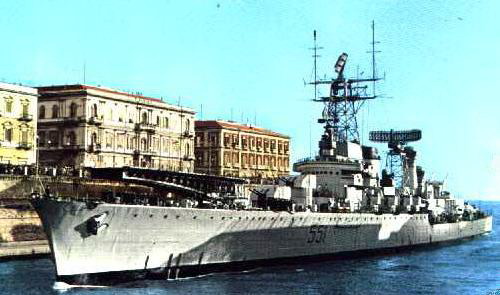
In 1948, Italy still had a considerable fleet of cruisers, survivors of WW2: Most of them were light cruisers of the superclass ‘Condotierre’, the old Cadorna (discarded 1951), the Raimondo Montecuccoli (taken in hands for modernization later), the Duca d’Aosta (To USSR in 1949), the Eugenio di Savoia (To Greece 1951), the two Duca Degli Abruzzi class, and four Scipione Africano class, of which two were transferred to France in 1948. Only the R.Montecuccoli, the two D.D.Abruzzi and two ‘Africano’ class left. The admiralty decided that due to their hull age, it was sound to modernize them in some extent. Therefore during the early phase of the cold war, Italy had seaworthy five cruisers, all pending modernization. It varied according to their size and age, and differed on all five. The smallest one, the G. Germanico and P. Magno were in-between destroyers and cruisers, and were rebuilt as large AA destroyers escorts and of course, renamed, San Giorgio and San Marco. Situation was more complicated for the mush larger three other Condottiere. The 8,500 tonnes R.Montecuccoli was the first modernized, taken in hands in 1947, and completed in 1949: This was a significant modernization as she was indeed converted as a cadet training ship (see later) and served in this role until replaced by San Giorgio, discarded in June 1964, so after a thirty years career.
But the most interesting and ambitious conversion was applied to the two Duca Degli Abruzzi class (which kept their names, still relevant in the context of cold war Italy), modernizations staged in 1949-51 and 1951-53 for the Guiseppe Garibaldi and D.D.Abruzzi respectively, and a second round for Garibaldi in 1960, which became for all intent and purposes, the first Italian missile cruiser, and one of the most extensive cruiser modernization in Europe, only comparable to the Colbert and Suffren in France, or the USN Cruisers of the Camberra class.
About the Montecuccoli
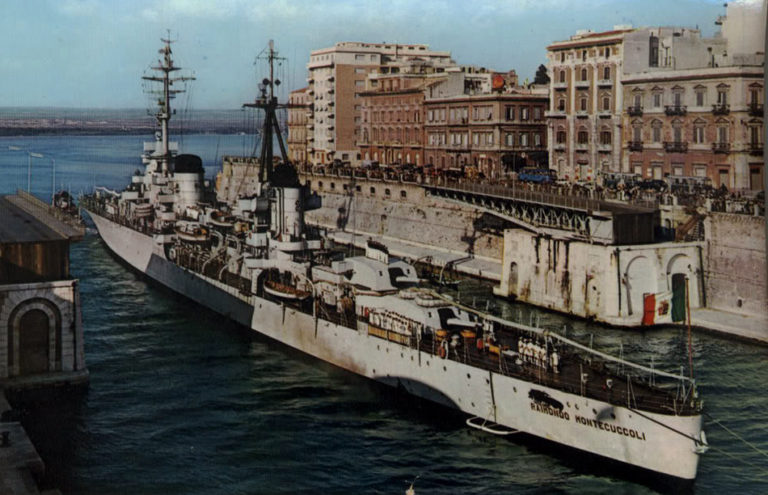
Launched in 1934, Raimondo Montecuccoli was the oldest of the large London treaty ‘Condotierri’ cruisers. At the armistice, Montecuccoli carried out 32 war missions covering 31,590 miles. During the co-belligerence period and until the end of the conflict, she participated in numerous missions of fast transport and repatriation of prisoners. After 1945 she was mothballed, pending her fate during peace negotiations. Granted eventually to Italy but only as a training cruiser, she was available for modernization.
R. Montecuccoli resumed her activity from 1947 until 1949 and after a maintenance refit involving minor changes, the admiralty prepared a design fit to best perform her new task of training ship for the students of the Naval Academy of Livorno. She was to carry out summer school cruises from the summer of 1949 in the Mediterranean and beyond, like to Santa Cruz de Tenerife in 1951, London in 1952. In 1953, she resumed her activities in the Mediterranean while the conversion draft was ready. In 1954, she was taken in hands for a reconstruction. This was performed by the Arsenal of La Spezia from June 1954. These modification made her more suitable as a training ship, fully compatible with NATO requirements as Italy just entered the organization. As completed, she was given the new serial number C552 acccording to NATO classification (C for cruiser).
Changes involved the elimination of two boilers, of the nº2 turret, together with its barbette and ammunition storage, the 100mm/47 AA turrets and their FCS, the four twin 20 mm/70 Breda machine guns, while their 37/54 twin mounts. They were all replaced by new 40/56 “Bofors” mounts. Electronics was installed for the first time, a surface radar, aerial surveillance radar, new fire control radars and a new firing center were installed. Fuel tanks were increased by 300 m³ with the space gained in the elimination of two boilers, giving an additional 615 miles of range. The appearance changed much, in particular for the central section of the ship, forward funnel and command bridge remodelled and a sturdy lattice mast installed to carry the radars and antennas and associated equipments.
Career:
Alternating fleet exercises activity with training cruises, Montecuccoli visited Copenhagen in 1955, Montreal, Boston and Philadelphia in 1958, Helsinki in 1961. The started a circumnavigation of the world from 1 September 1956 to 1 March 1957 and represented Italy in Australia in conjunction with the Melbourne Olympics at the time the Suez Canal was closed. By then under command of captain Gino Birindelli, she visited 34 ports on four continents, for a grand total of 33,170 miles. She made one more circumnavigtion, this time of the African continent in 1963, but her age meant she was disarmed in Taranto on 31 May 1964. She was mothballed for a time, then towed to La Spezia and in 1972 scrapped for good. In 1965 she was replaced as a training ship by the AA destroyer escort (ex cruiser) San Giorgio.
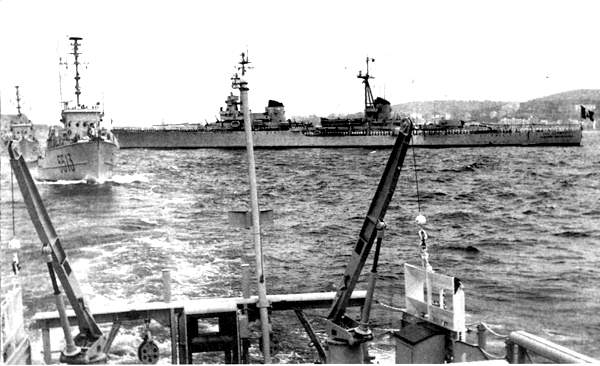
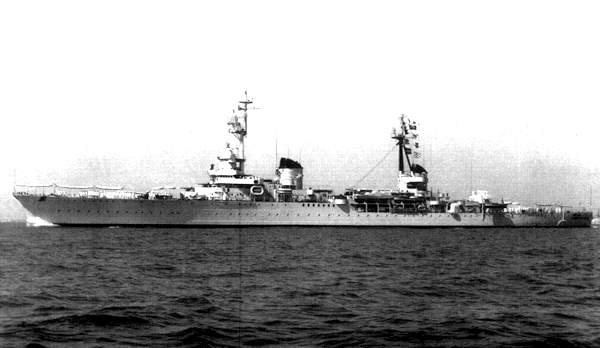
The Raimondo Montecuccoli in 1960.
Reconstruction of the Duca Degli Abruzzi (1949-51)
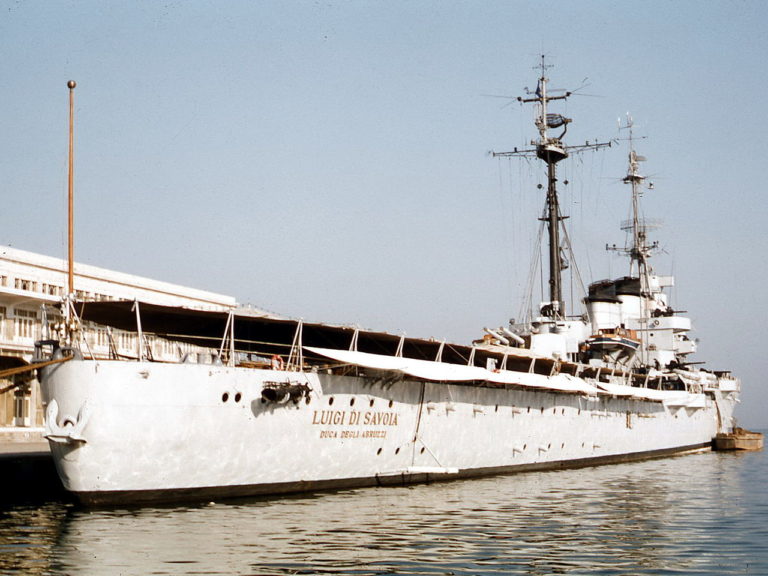
Together with her sister ship, Garibaldi, Cadorna and Montecuccoli, this was the cruiser force of postwar Italy, spared by events of war reparations. Luigi di Savoia Duca de Abruzzi was called the “cruiser of the exiles” as she carried the royal family of Italy into exile, when King Vittorio Emanuele III first left for Alexandria in Egypt, with the title of “Count of Pollenzo” after signing a formal abdication in Naples, in favor of his son Umberto II. After the war the first modernization came with the installation of an L.W.S. radar installed on top of the mainmast, of the British type 293, characterized by its crossed dipole frame antenna. Between 1951 and 1953, a more extensive modernization started.
New Electronics
The forward superstructure was completely rebuilt, giving a new aspect to the bridge and the conning tower, while a new and sturdier tripod mast was installed to carry the weight of a larger parabolic air-naval discovery radar of the type SK 42, later replaced in turned by the US-built AN/SPS-6 search radar. An odometer radar was also placed on the mainmast, used as an altitude rangefinder. The same was also installed on San Giorgio as modernized (ex-Capitani Romani class).

HD rendition of RN Luigi di Savoia Duca Degli Abruzzi in 1953
Armament:
-The cruiser kept her armour and main artillery, the same ten 6-in guns in triple and twin turrets for and aft. However her AA was no longer relevant in the jet age.
-The secondary armament therefore was deposed and replaced entirely by twenty-four 40mm/56 pompom guns in four quadruple mounts and four twin, but two 100 mm/47 mm twin guns were kept, aft. This constituted a new, more modern anti-aircraft armament for the 1950s standard.
Propulsion
The powerplant was modified as well, but no modernized. Priorities changed and the radius of action was now preferred to excessive speeds. Two boilers were retired, reducing the output and max speed to 28 knots.
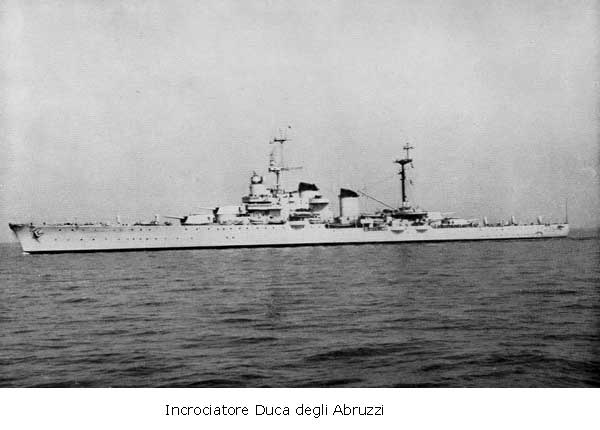
Back in Action
On 26 October 1954, the cruiser was in Trieste, and departed escorted by the destroyers Granatiere, Artigliere and Grecale, back to Italy with the cheering crowd and great joy for the crews returning home. The ship took part in the parade of November 4, held in the presence of President Einaudi, with all ships exhibiting the great pavese, including the cruiser Montecuccoli, the TBs Libra and Cassiopea while Duke of Abruzzi remained in Trieste, Artigliere and Vespucci and the students of the Naval Academy of Livorno on board. Until 1956-57 she was the only full-time cruiser in the Navy, as Cadorna was decommissioned since 1951, Montecuccoli refitted as training ship and Garibaldi in reserve and planned in 1957 for reconstruction. In 1956, Andrea Doria was decommissioned and the Duke of Abruzzi became the headquarters C-in-C and flagship of the Italian Navy, the Marina Militare. In 1961, she was decommissioned, and her moderized sister Garibaldi took the role of flagship in her place.
1st Reconstruction of the Giuseppe Garibaldi (1951-53)

Giuseppe Garibaldi after her first refit in 1952
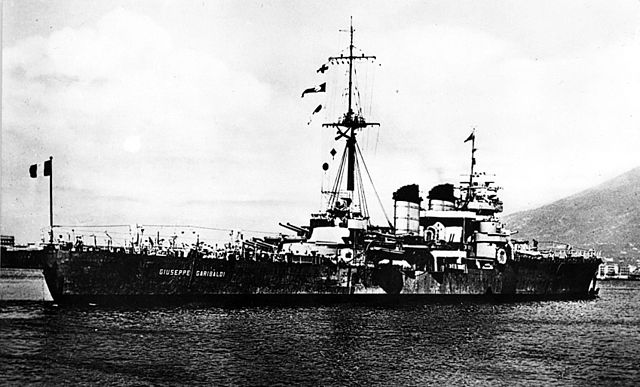
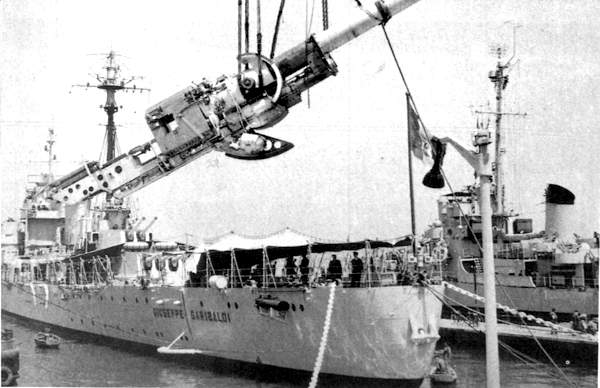
Modernization of the Garibaldi: In 1947 (top) and its 152 mm/55 guns and turrets removed during reconstruction
It would be plain false to see all four cruisers spared by the peace treaty operating together after the war: Cadorna was disarmed almost immediately after the war, while Montecuccoli now operated as training ship for the naval academy of Livorno, leaving the Garibaldi pair as active cruisers in the new Republican Marina Italiana.
Giuseppe Garibaldi was taken in hands after Abruzzi, but already in 1946 her torpedo tubes were removed as well as the catapults and aircraft facilities, now obsolete. A British type radio telemeter NSA-1 was installed. In 1947-1948, Garibaldi underwent a larger modernization, with minor changes in the superstructure and a reinforced foremast to accomodate an American SO 8 radar and a SK 42 parabolic radar on their respective platforms, also used by the San Marco, San Giorgio and her sister ship Duca degli Abruzzi, on a lowered mast. In place of the former TTs, two 100/47 mm guns were installed in 1947 for illumination while the secondary armament was completely overhauled:
It consisted in ten 100 mm/47 guns and six twin 37mm/ 54 plus four single 20mm/70 Oerlikon guns and four 20mm/65 mm Breda. Well prove, they were easy to use and maintain and came with a large variety of ammunitions, tracer, tracer-explosive, with time-fuse, and others.
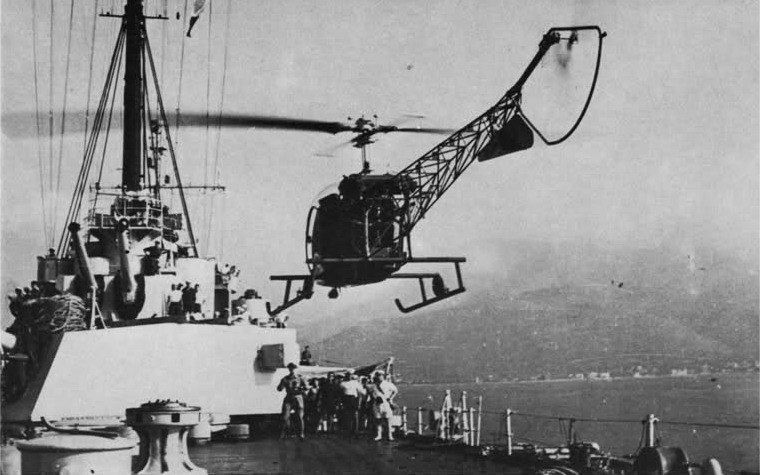
Tests of the Bell 47 (locally built as AB-47G on Garibaldi, 1953 in the gulf of Gaeta
Also, an helicopter platform was erected aft, just large enough to accomodate a Bell 47 helicopter. The latter started a testing campaigns of landing and take-off tests, off the coast of Gaeta during the summer of 1953. After the positive outcome Navy made anti-submarine helicopters standard on its destroyers and frigates, and fixed or telescopic hangars depending on the space available. The need for helicopters would just grow exponentially as much was perceived the Soviet submarine threat, which started to appear in the Mediterranean in the 1960s. Some indeed were spotted coming from the Albanian base in Valona. Thus began the development of a new category of helicopter ASW ships, pioneered by Italy. The Bergamini-class frigates much later were a development of a serie of ships started with the first helicopter cruisers in the world, the Doria-class, which pioneered arrangements later adopted for the much larger Vittorio Veneto and became standard for all subsequent constructions.
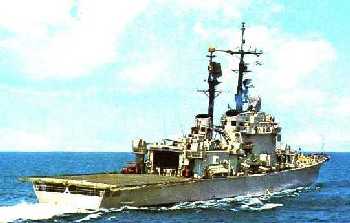
The Caio Duilio of the Doria class helicopter cruiser. Bell 47 tests performed on the Garibaldi allowed this radical new construction.
Further modifications were done on the main bridge superstructure, with the armour partially removed, and new electronic surveillance arrays of American type, plus the navigation radar type S.O. 13, later replaced by the domestic S.M.A. model later, and an air search radar with a large parabolic antenna mounted aft on a dedicated lattice mast.
After a short operational life during which she participated in the large scale inter-allied GRAND SLAM exercise, Garibaldi was placed in the reserve in 1953, pending her fate. By December 1954, decision had been taken to convert her completely in La Spezia Arsenal as a missile cruiser.
Garibaldi as a missile cruiser (1960)
In 1957, Garibaldi was scheduled for a scrapping of all the superstructure and most of the hull interior, to left it bare, down to the engine floor level. The transformation work started at the end of 1957 while Cadorna already was disarmed and Montecuccoli in training, leaving the Duca degli Abruzzi aas the sole Italian cruiser in service, used as flagship after the Duilio was disarmed in 1956.
The design of the reconstruction at superstructure level implied new arrangement for the future electronics, heavier masts to support large aerials, antennas and radars, also making provision for a Terrier missile system, which was the main goal of the whole operation and occupied a large portion aft of the hull, also with fire control systems and a central operation. The rest of the hull was also modified to include a new, modern AA arrangement so the old 6-in turrets, barbettes, storage ammunitions were removed. Lots of space were left for future modular adaptations as well.
The Arsenal of La Spezia was tasked for this radical reconstruction, completed in 1961 (1957-1961, so five years). It was certainly one of the most radical reconstruction of a WW2 cruiser in Europe, on par with the French Colbert in 1970, the Dutch De Ruyter class or the Swedish Gota Lejon, the British Tiger class, in less extent. But their most direct reference was the reconstruction of the Albany class fleet escorts, former Baltimore class hulls recommissioned in 1962, with a major difference, the latter were much larger and displaced twice as much, and accommodated several missile systems at once, making them far more complex overall.
Reconstruction of the hull
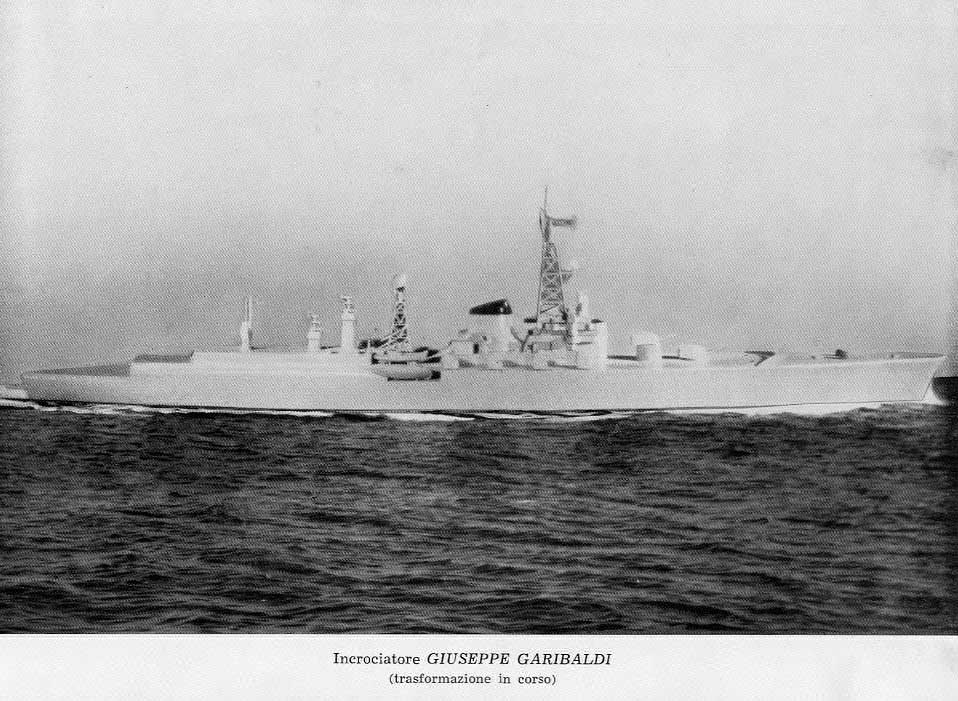
A model of the Garibaldi as rebuilt
After her radical reconstruction, Garibaldi reached a standard displacement of 9,802 tons, 11,350 fully loaded (vs. 9387 t/11262 t FL in 1937), her keel however slightly less deep at 6.7 meters vs. 6.8 originally. The only part not modified to a great extent was the hull, which retained its original dimensions and configuration. Needless to say, most of the armour was gone, therefore the heavier displacement gives some clues about the equipments that were added to the ship. The hull was lower than the original but kept its forecastle. The aft section of the hull and the stern were rebuilt, notably with a transom stern. The closing of all openings but on the upper forecastle deck allowed the installation of a ventilation and air conditioning system in closed loop, which allowed an efficient NBC defense system, relevant under modern NATO standards. There was a massive superstructure aft starting at the forecastle step, about 90 meters long and this large deckhouse housed the complex Terrier missile system. The volume was increased as well as the ship’s hydrodynamic trim.
Armour:
What remained concerned only sensitive part of the ship, which was originally slightly better armed than the earlier Condotierre series and optimized against 6-in shells only. The main belt, armoured deck longitudinal and transverse bulkheads were all removed, but armour was kept in places:
Vertical armor deck 100 mm, partial central belt 40 mm (notably around the new central operation), artillery turret faces and barbettes 135 mm, internal conning tower 140 mm. The major change for the vertical armor was the commission of a add-on 30 mm stray over the machinery, steering room and ammo storage.
Powerplant and performances
Two boilers of the aft boiler room were removed, while the other engine rooms were unchanged, one funnel eliminated by truncating the exhausts. Exhaust pipes of the six remaining boilers were therefore modified, and auxiliary made, to widen the base of the single funnel. The power dropped to 85,000 hp, top speed to 30 knots (55,56 km/h), which was still very reasonable. This coincided with a reduction in fuel consumption, so the Garibaldi could now reach 4,500 nm at 18 knots (vs. 4,125 nm at 13 kts), while revised arrangements limited maximum fuel capacity, down to 1,700 tons. The boilers were completely overhauled and cleaned anew, as well as all the gauges and indicators, pipes, and the turbines disassembled, cleaned and reassembled. If the revised powerplant did not bring much change, less speed and more range, it was not sufficient to provided the power-hungry new electronics installations.
To cope with the energy needs it was necessary to install four Tosi-Brown Boveri turbo-alternators, in addition to two Fiat-Brown Boveri diesel-alternators generating alternating current at 440V for a total of 4,000 Kw, and overall power onboard of 89,000 shp (70 000 kW). It was a provision for future revisions, and sufficient to illuminate a city of 200,000 inhabitants.
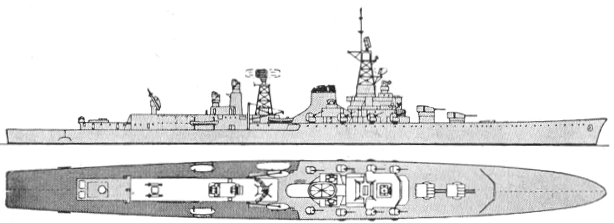
2-views of the cruiser (src navypedia)
Gun Armament
The Garibaldi was yet not a pure missile cruiser, but her armament was modern and dual purpose, although still giving her a silhouette reminiscent of the old conventional vessel. As rebuilt, she was indeed given two twin turrets, with cannone da 135mm/45. This was completed by eight single cannone da 76mm/62 by OTO Melara for pure AA defense, all arranged along the forecastle superstructure bridge.
135/45 mm guns: Distributed in two twin turrets forward these were the same dual purpose guns designed in 1942-43 for the Capitani Romani class and later fitted on the rebuilt Battleship Duilio. The 135mm/45 guns, which in the Garibaldi were installed in fully automated turrets. can be considered the best Italian naval guns in the Second World War, with a range of 19.6 km and a rate of fire of 6 shots per minute, and were capable of performing very precise shots, but, with an elevation of 45 ° however, they lacked satisfactory anti-aircraft capability, if not a barrage. In 1968 the barrels were lengthened and the 135/53 guns had to be installed on the Audace, then in design. The turrets were installed in a superfiring configuration forward, superficially looking like their former artillery. Due to the age of this weapons system, it was seen as a compromise for those in the Navy still trusting a relatively heavy artillery. The Doria and Veneto class will not have any such system and relied on smaller SAMs and antimissile systems. So that was a transitional move.
76mm/62 guns: These were newly designed and extensively tested on the Carabiniere, a rebuilt postwar destroyer, and was introduced to the Navy at large during the sixties. It was soon found onboard the Bergamini class destroyers and Alpino class frigates, Doria and the Vittorio Veneto class cruisers. It was replaced in turn by the classic OTO Melara “super rapido” 76mm/62 Compact first installed on the Audace class destroyers.
The 76/62 MMI “Enlarged” were a pure dual purpose weapon, with water-cooled barrels, and mixing electric and hydraulic power for elevation and traverse, with manual backup in emergency. Its range was just 18.4 km with HE shells (6.296 kg) at 45 °, while at 85° it dropped to 4km. Traverse rate was 70°/s, and elevation rate 40°/s. The turret accommodated a single crew member. The Cannone da 76/62 from OTO was the evolution of the SMP-3 model which had been embarked on the introduced first on the Albatros class corvettes of 1955. There was also a tandem version with overlapping barrels of this weapons system tested on the Centauro class frigates, but it was not successful and not adopted elsewhere.
Missile armament
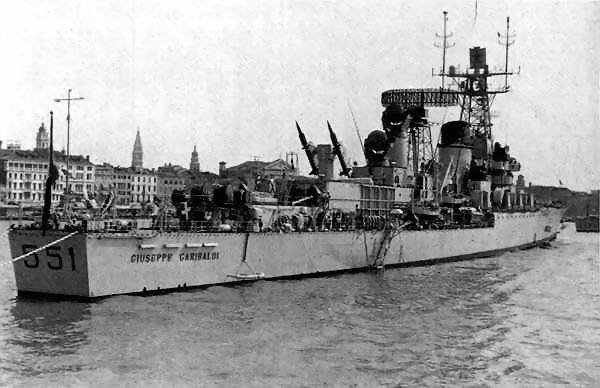
Rear view of the Garibaldi and its Terrier missile system. The reload system took most of the aft part of the ship.
It was quite impressive as well, with missiles that had unique capabilities, rarely seen outside the US. It consisted in:
-A twin launcher for the RIM Terrier SAM
-Four UGM-27 Polaris in silos (from 1967)
The the installation in an aft deckhouse of the American Terrier missile system, made the Garibaldi the first European missile cruiser, and a landmark for NATO history. The origins of this transformation work was the need of a protective bubble against Soviet bombers, so from medium to long-range. It was needed a missile system capable of launching two double-stage missiles, simultaneously and independently guided towards their own targets. Terrier missiles were at the time the best SAM available, and only the USA possessed them. Other systems were used such like the Bundesmarine with the Lütjens class destroyers and their Tartar SAM. The large Terrier derived from Talos but then evolved independently. More on this on the cold war early USN missile cruisers. The Terrier launched a relatively smaller missile than the Talos, with small opening fins maximizing range and speed and reducing drag. The Garibaldi was fitted with the standard Mk 10 twin launcher ramp also used on USN cruisers, and fully stabilized on three axis, so proven on any sea state. The later Vittorio Veneto adopted the Mk 20 Aster also seen on the Belknap class. Italy was the only country for which these missiles were exported, showing the close ties and trust between this country and the USA.
For propulsion, the Terrier had an acceleration booster and additional solid fuel rocket at the rear and carried a 100 kg fragmentation warhead which was placed at the middle of the missile body. First tests started at the ship’s first post-reconstruction cruise on the US coast, on 11 November 1962 in San Juan of Puerto Rico, and this was also the first missile launch by any Italian unit.
The Terrier launch system was assisted by an equally modern electronics and guiding suite, also built in the US and adapted for the Italian cruiser. This was the “Argos” 5000 radar, tasked on locking the target at long distance, and passing the info to a three-dimensional AN/SPS-39 radar which calculated the direction, distance altitude with precision, the data passed on the missile to setup its course. The Terrier’s own guidance systems guided the missing through electromagnetic emission to the target. On board operations of all armaments were managed in the Combat Operations Center, processing process data acquisition and coordination. The Terrier missile were stowed below the twin launcher aft, as in the Boston and Canberra, while subsequent cruisers later had horizontal chain reload systems. According to US practice, the stowage contained as much as 72 missiles, but probably less due to the reduced dimensions of the Italian cruiser compared to its USN counterpart.
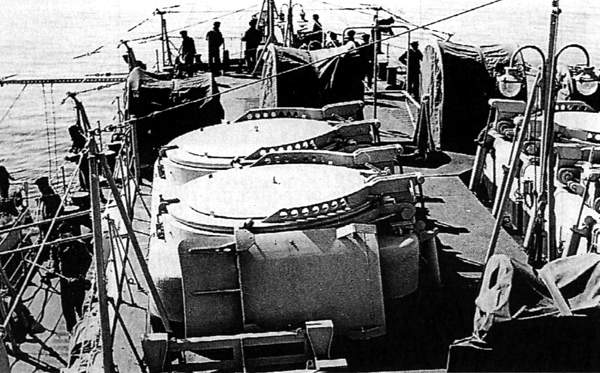
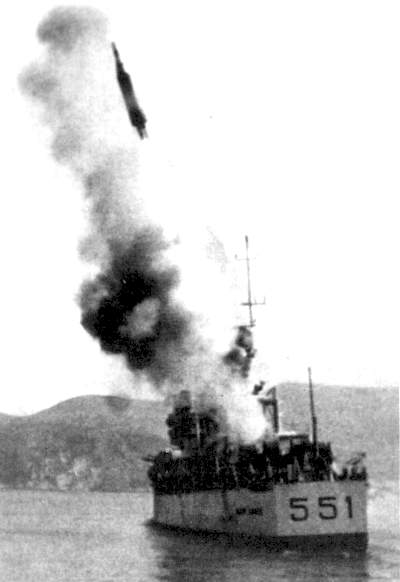
Two rows of Polaris missile tubes were sunk into the deck abaft the Terrier magazine.
The Polaris missiles were another additions made during a partial reconstruction and modernization in 1966-67. All four silos were installed aft of the ship, close to the stern. These UGM-27 systems were the first SLBM fitted on USN Submarines, entering service in 1961 and also used by the British. It was a long range ballistic vector which usually could receive a nuclear warhead. Its first stage used an Aerojet General Solid-fuel rocket and the second stage a solid propellant Hercules rocket. Range was 2,500 nautical miles (4,600 km), enough to strike from the Aegean sea most cities in Ukraine and southern Russia. Its trajectory and speed of 8,000 mph (13,000 km/h) make it unstoppable. It also used thrust vectoring for corrections and accuracy was about 3,000 feet (910 m). This made the Garibaldi the only European surface ship fitted with such system. Details of their adoption is still classified, but it is agreed to be part of a US-led NATO program at the time to more largely distribute the Polaris, including onboard cruisers. Italy did not had any deterrence capability at the time, so basically the Polaris onboard the Garibaldi would have been re-equipped in emergency with nuclear warhead in case of war, “on loan” by US Forces in a nuclear war context. Their accuracy compared to the later Harpoon, was poor, so using conventional warheads would have made little sense. Nevertheless, their installation was made in parrallel to the installation in Italy of the Jupiter SLBMs, the Polaris being their sea-going equivalent, as a compensation for the retirement of Turkish missiles after the Cuban missile crisis.
New electronics
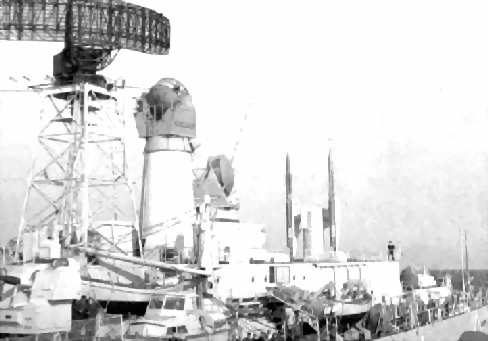
Radars and FCS on board the Garibaldi, aft view
The main onboard electronics on the cruiser took place between two large quadruple lattice masts, tailor built for the Garibaldi and reused on the Doria class cruisers. On the first of the two pylons at the top of the bridge-tower complex (reminiscent of the converted Boston class cruisers) was installed a three-dimensional frequency scanning air surveillance radar (FRESCAN) AN/SPS-39. It was commonly adopted on first NATO missile launchers and coupled with the Westinghouse AN/SPS-6 two-dimensional air-naval surveillance radar. Other platforms supported the SET-6B surface surveillance radar and SMA CFL3-C25 navigation radar. The second pylon aft of the funnel carried the large, domestic Selenia Argos 5000 aerial detection radar. Under favourable conditions, frequent in the Mediterranean, it could identify targets up to 500 miles.
The AN/SPS-39 FRESCAN was the only three-dimensional radar excluding the British Type 984 (much heavier, Victorious and Hermes CVs) and only such system in Europe. It used a single antenna to obtain the relative data at altitude, range and bearing or incoming aircraft and was equipped with lightweight electronic stabilizers ensuring stale operation regardless of the roll and pitch. The Westinghouse AN/SPS-6 radar had a range of 250 km and registered itself in a decisive turning point towards standardization and modernization of radars from 1954 in the Italian Navy. The Garibaldi embarked the system at the end of the transformation work. It was also carried by the Gabbiano class corvettes.
The top of the deckhouse aft supported two Sperry-RCA AN/SPG-55 lighting and guidance radars managing the twin Mk 9 Mod.1 launch Terrier launchers. It was stabilized on three axes and the firing control systems for guns was of domestic production, also by Selenia.
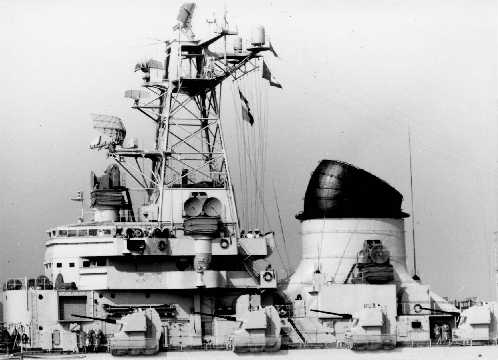
Forward electronics, radars and FCS on the rebuilt bridge as of 1961
Second career of the Garibaldi (1961-1972)
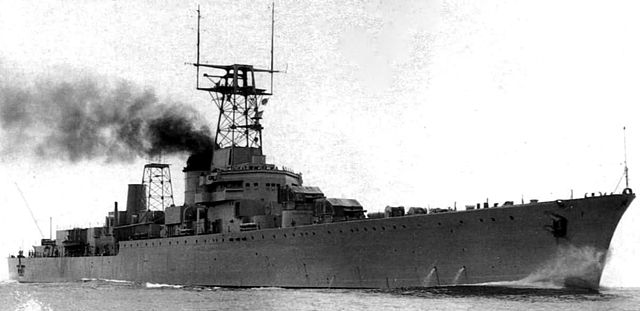
Garibaldi in 1960, right after her second modernization
At the end of her reconstruction, Garibaldi was recommissioned on November 3, 1961 and sailed to Taranto on February 5, 1962. By September 1962, she carried out a first series of tests in Italy, still without her electronic equipments and missiles. She was sent to the United States for to represent Italy and the final missile arrangements installations, including the guiding systems and radars, loading systems, followed by the completion of the training phase. In early November 1963 she moved to San Juan of Puerto Rico, started her missile launch tests in the waters of the Caribbean Sea. This started on 11 November 1962 and this was successful campaign. She returned to Italy on 23 December 1962, and the next year she was modified, lengthening her remaining funnel to prevent exhaust gases interfering with the new electronic equipment, also inclined and fitted with a remodelled funnel cap, conducting smoke aft. Full operational readiness combat flag was delivered in Naples on 10 June 1964, by the ANMI group of Rome to the commander, Captain Aldo Baldini, ceremony attended by the Commander in Chief Admiral Alessandro Michelagnoli and the Undersecretary of Defense, Natale Santero.
The Garibaldi served for ten years in the first phase of her deployment, as a command ship and flagship of the Italian Naval Squadron, participating in training and representation activities in the Mediterranean and abroad. Garibaldi (C551) would be replaced twenty-four years later by the light aircraft carrier of the same name and numeral, Giuseppe Garibaldi (C551). The Garibaldi was assigned to the 2nd naval group, 2nd Naval Division at Taranto and between the fall of 1964 and 1965 she underwent maintenance work. The massive aft Argos 5000 radar antenna was replaced by an upgraded smaller and and lighter model, notably in order to lessen wind resistance. Her base was built directly above the former armoured command tower. There was another maintenance period between 25 August 1966 and 20 April 1967, made at La Spezia. In this, the Microlambda SET-6B radar was replaced by the new MM/SPQ surface discovery and navigation radar which had a 50 km range and was produced in Italy. The quad foremast was modified, more compact and the support mast for the Terriers radar FCS were moved at the end of the deckhouse, while wells for Polaris missiles were installed.
On June 4, 1968, Garibaldi took part in a naval parade in the Gulf of Naples for the 50th anniversary of the victory in World War I. This was the largest naval parade in Italy after ww2 and she hosted for the occasion the President of the Republic Saragat accompanied by the Minister of Defense Tremelloni, and Diplomatic Advisor Francesco Malfatti, military adviser Admiral Virgilio Spigai. The reception was hosted by the “Basso Tirreno” maritime department head for Naples, admiral Raffaele Barbera. The ship then proceeded to the parade under command of Captain Antonio Scialdone and Admiral Roselli Lorenzini.
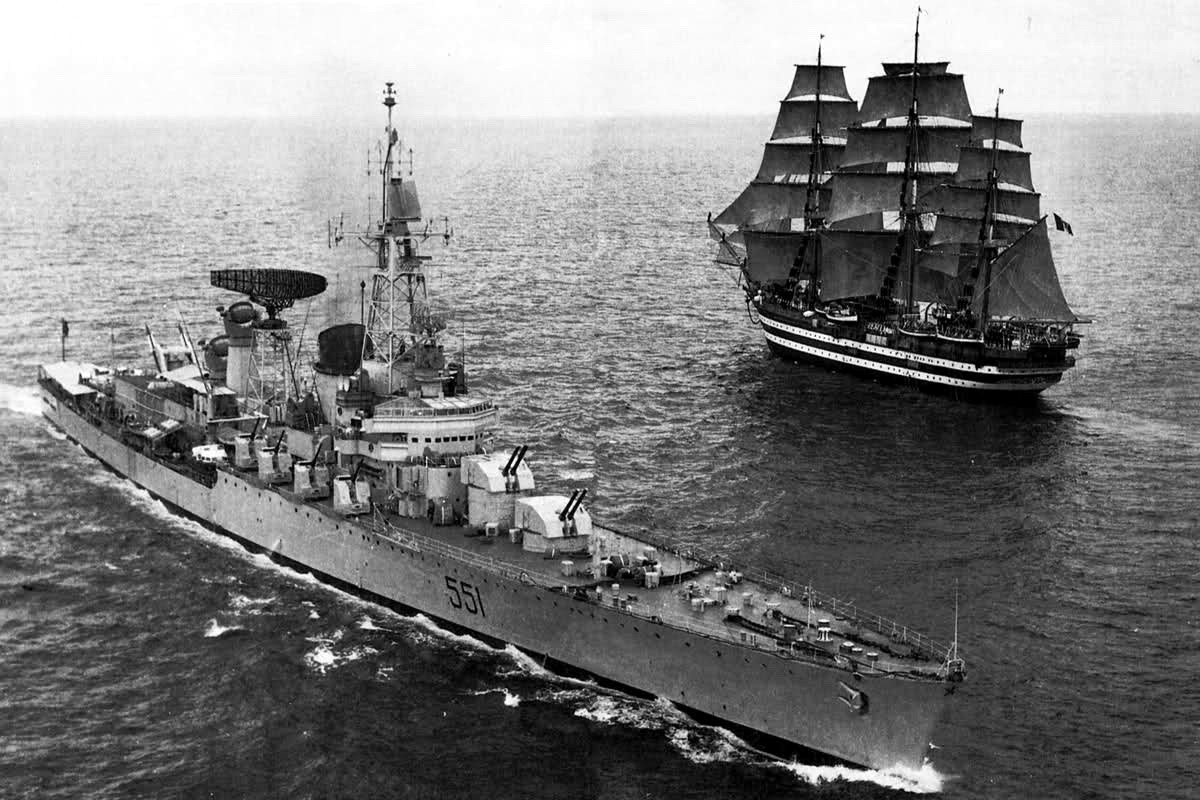
Traditions and history: The Garibaldi crossing the schoolship Amerigo Vespucci off naples in 1968
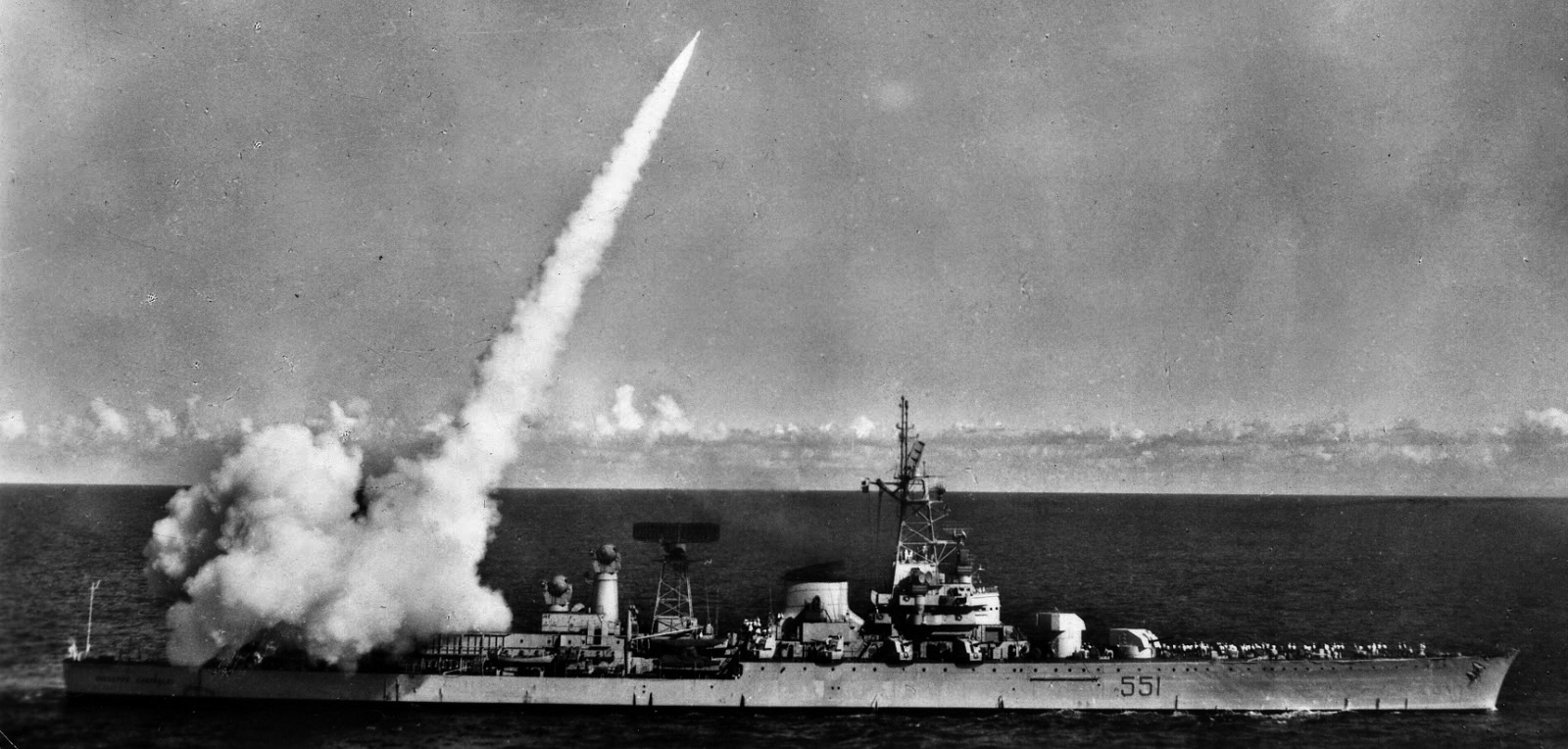
The Garibaldi launching a Terrier, side view
The Garibaldi flew during the parade the presidential banner on her main flagpole, and sailed with San Giorgio off the gulf, proceeding towards Procida, Ischia and Capo Miseno, and close to the Vittorio Veneto as the latter was prepared to replace her as flagship in the future. This parade was a national event where most of the government and military officials of all branches were also present. It was followed nation-wide, retransmitted in real time by the RAI. Between 1968 and 1971, Garibaldi resumed her training exercises, but budget cuts decided of her fate as well as pending replacement by Veneto and an ageing weapons system. The Terria was a first-gen SAM and already replaced in the USN by the standard. There was no plan to rearm her with this system, which would have needed extensive modifications.
As a consequence the admiralty chose to program the Garibaldi’s decommission. She was disarmed on February 20, 1971, mostly officially based on budgetary restraints. In February 1970, a press conference was held on board the Garibaldi by the squadron C-in-C Admiral Gino Birindelli, denounced the Navy budget cuts and the state of a profound moral and material malaise for the staff in this ship. Birindelli’s declarations triggered many reactions in the political class but restrictions were maintained and the new Chief of Staff Admiral Virgilio Spigai was forced to withdraw the cruiser from service, justifying the decision as being the oldest in service and for maintenance costs, even ten years after her conversion. This went not well along a tense situation in the Mediterranean, following the Yom Kippur war and increasing Soviet presence. By November 1973, the new Chief of Staff of the Navy, Admiral Gino De Giorgi, published the “White Book of the Navy” in which he underlined the impossible commitments of Marina Militare in possible war scenarios in the region, and towards its obligation to NATO, due to massive budget cuts. The document however had some influence in the Naval Law of 1975 starting a substantial modernization of the fleet.

Author’s HD Illustration of the Garibaldi as completed in 1964
Many experts, in Italy and abroad, and inside NATO, esteemed the retirement of the ship after a costly and long modernization after just a decade of service was even compounded by the useless Polaris installation, also expensive; In good conditions, Giuseppe Garibaldi was however suitable to be used as a museum ship, given her great historical significance. She was indeed the first European missile cruiser and first surface ship worldwide equipped with ballistic missiles and had a lot of significance for the operational and logistic structures modernization of the modern Italian Navy. The Montecuccoli which was the first Italian cruiser to circumnavigate the globe was also at her time expected to be preserved. The well-trained crew of the Garibaldi would find its place nevertheless in the new helicopter/missile cruiser Vittorio Veneto, as new flagship of the fleet.
The Garibaldi was discarded on November 16, 1976 and by November 3, 1978 crossed under the Ponte Girevole and through the Taranto canal to reach La Spezia, for demolition work to proceed. It went on at the Cantieri del Tirreno in Genoa.
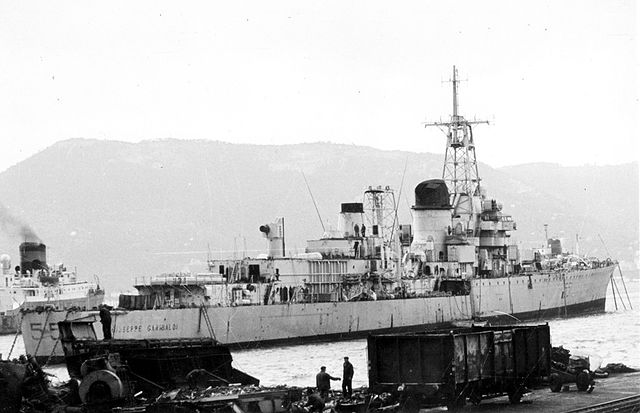
The Garibaldi in 1978, pending scrapping
Read More/Src
//it.wikipedia.org/wiki/Raimondo_Montecuccoli_(incrociatore)
//it.wikipedia.org/wiki/Giuseppe_Garibaldi_(incrociatore_1936)
//www.cherini.eu/mmi/02%20Incrociatori/slides/1953%20-%20%27Duca%20degli%20Abruzzi%27.html

 Latest Facebook Entry -
Latest Facebook Entry -  X(Tweeter) Naval Encyclopedia's deck archive
X(Tweeter) Naval Encyclopedia's deck archive Instagram (@navalencyc)
Instagram (@navalencyc)





 French Navy
French Navy Royal Navy
Royal Navy Russian Navy
Russian Navy Armada Espanola
Armada Espanola Austrian Navy
Austrian Navy K.u.K. Kriegsmarine
K.u.K. Kriegsmarine Dansk Marine
Dansk Marine Nautiko Hellenon
Nautiko Hellenon Koninklije Marine 1870
Koninklije Marine 1870 Marinha do Brasil
Marinha do Brasil Osmanlı Donanması
Osmanlı Donanması Marina Do Peru
Marina Do Peru Marinha do Portugal
Marinha do Portugal Regia Marina 1870
Regia Marina 1870 Nihhon Kaigun 1870
Nihhon Kaigun 1870 Preußische Marine 1870
Preußische Marine 1870 Russkiy Flot 1870
Russkiy Flot 1870 Svenska marinen
Svenska marinen Søværnet
Søværnet Union Navy
Union Navy Confederate Navy
Confederate Navy Armada de Argentina
Armada de Argentina Imperial Chinese Navy
Imperial Chinese Navy Marinha do Portugal
Marinha do Portugal Mexico
Mexico Kaiserliche Marine
Kaiserliche Marine 1898 US Navy
1898 US Navy Sovietskiy Flot
Sovietskiy Flot Royal Canadian Navy
Royal Canadian Navy Royal Australian Navy
Royal Australian Navy RNZN Fleet
RNZN Fleet Chinese Navy 1937
Chinese Navy 1937 Kriegsmarine
Kriegsmarine Chilean Navy
Chilean Navy Danish Navy
Danish Navy Finnish Navy
Finnish Navy Hellenic Navy
Hellenic Navy Polish Navy
Polish Navy Romanian Navy
Romanian Navy Turkish Navy
Turkish Navy Royal Yugoslav Navy
Royal Yugoslav Navy Royal Thai Navy
Royal Thai Navy Minor Navies
Minor Navies Albania
Albania Austria
Austria Belgium
Belgium Columbia
Columbia Costa Rica
Costa Rica Cuba
Cuba Czechoslovakia
Czechoslovakia Dominican Republic
Dominican Republic Haiti
Haiti Hungary
Hungary Honduras
Honduras Estonia
Estonia Iceland
Iceland Eire
Eire Equador
Equador Iran
Iran Iraq
Iraq Latvia
Latvia Liberia
Liberia Lithuania
Lithuania Mandchukuo
Mandchukuo Morocco
Morocco Nicaragua
Nicaragua Persia
Persia San Salvador
San Salvador Sarawak
Sarawak Uruguay
Uruguay Venezuela
Venezuela Zanzibar
Zanzibar Warsaw Pact Navies
Warsaw Pact Navies Bulgaria
Bulgaria Hungary
Hungary

 Bundesmarine
Bundesmarine Dutch Navy
Dutch Navy Hellenic Navy
Hellenic Navy Marina Militare
Marina Militare Yugoslav Navy
Yugoslav Navy Chinese Navy
Chinese Navy Indian Navy
Indian Navy Indonesian Navy
Indonesian Navy JMSDF
JMSDF North Korean Navy
North Korean Navy Pakistani Navy
Pakistani Navy Philippines Navy
Philippines Navy ROKN
ROKN Rep. of Singapore Navy
Rep. of Singapore Navy Taiwanese Navy
Taiwanese Navy IDF Navy
IDF Navy Saudi Navy
Saudi Navy Royal New Zealand Navy
Royal New Zealand Navy Egyptian Navy
Egyptian Navy South African Navy
South African Navy






























 Ukrainian Navy
Ukrainian Navy dbodesign
dbodesign